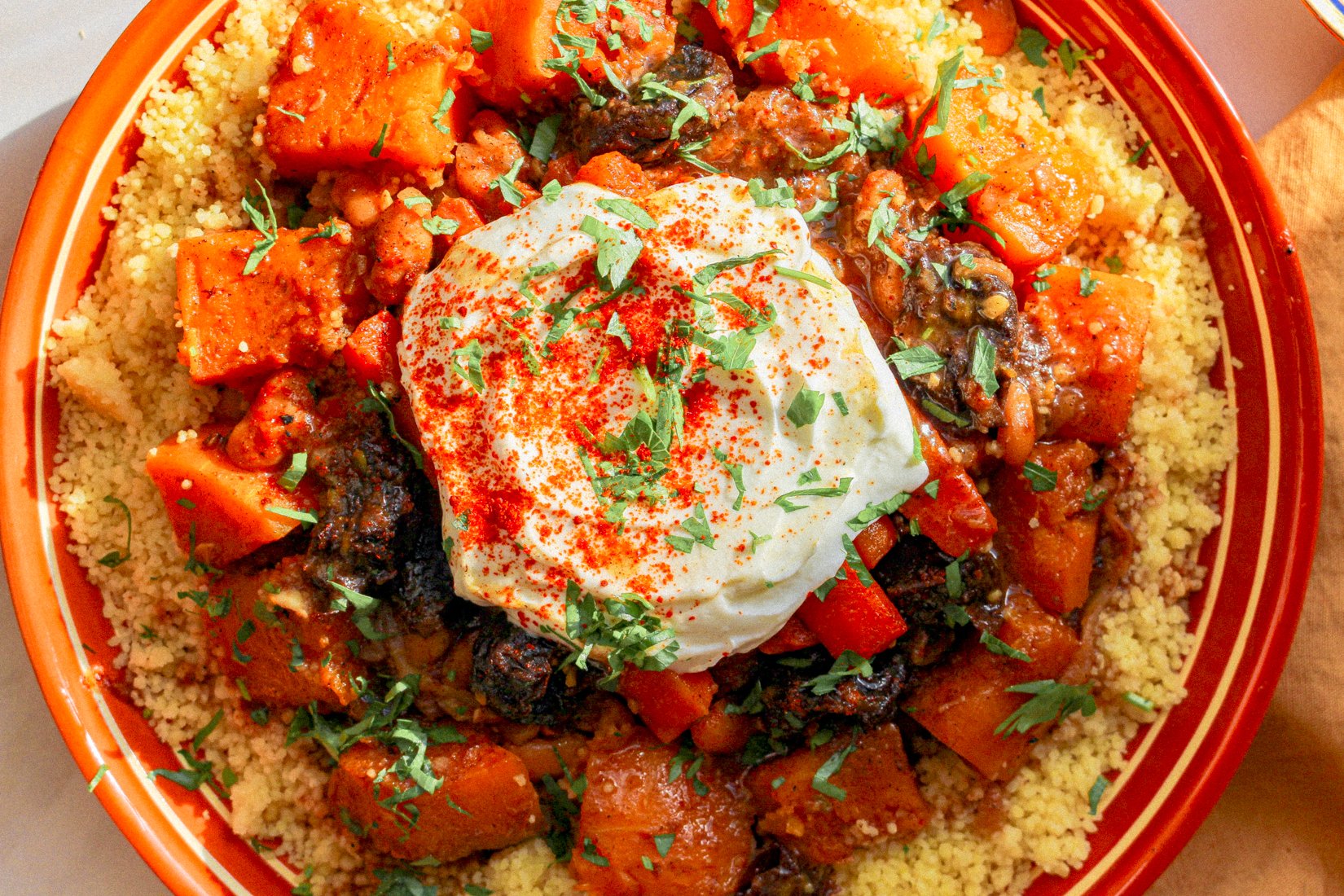Tfaya-Inspired Vegetable Tagine
Tagine, a staple within Moroccan cuisine and cooking, is a stewed dish that blends bright and prominent flavors found across the Maghreb region. “Preserved lemons and olives”, “prunes and onions”, and spices like nutmeg, saffron, and cinnamon are all different components this dish can be made with- resulting in a bite that is equal parts comforting, full of flavor, and guaranteed to be devoured in an instant.
Tagine is the name for both the dish and the traditional clay pot that it is cooked within. These clay pots are often decorated with different carvings or ornamenation. The tapered lid allows for the condensation released during cooking time to be returned back to the bottom of the pot, creating the most ideal condition for the array of ingredients being cooked to stew and absorb all the various flavors used.
This vegetable tagine is inspired by lamb tagine with prunes that my father would make often during my childhood. I remember being so amazed of the warm aromas from cinnamon and nutmeg paired with the sweet juices that escaped from rehydrated prunes- all being absorbed by juicy chunks of baby lamb. This dish also pulls inspiration from “tfaya"- a traditional moroccan garnish of caramelized onions and raisins that bring a wonderful depth to any dish (similar to the depth that browned butter brings to cookies or mashed potatoes).
Make this during times when you need an exxtra hug, during the long cold winter months, or for the most special person in your life.
Tfaya-Inspired Vegetable Tagine with Prunes
Time: 45 minutes to 1 hour
Serves: 4 to 6 servings
INGREDIENTS
1 yellow onion, thinly sliced
4 garlic cloves, minced
4 tablespoons olive oil
1 1/2 teaspoon salt
3/4 teaspoon ginger
3/4 teaspoon cinnamon
1/4 teaspoon nutmeg
Pinch of saffron
(1) 15-ounce can of navy or cannellini beans
2 parsnips, halved
4 carrots, halved and cut into 1/2” strips
2 cups butternut squash, cubed
1 cup water
1/2 tablespoon orange blossom water
1 tablespoon honey
1 cup dried prunes
cous cous, to serve
chopped parsley, to garnish
DIRECTIONS
Begin by preparing and chopping all of the veggies. Cut your yellow onion in half and thinly slice each half. Mince your garlic cloves and set them aside. Peel your butternut squash, carrots, and parsnips. Cube the butternut squash into even pieces, halve the parsnips, and cut the carrots into halves, then halves lengthwise, then into 1/2” strips. Prepare your spices by adding them to a dish and set them aside.
If using a tagine: heat olive oil in the tagine on a diffuser over medium heat (this protects the bottom of the clay pot that should not be exposed to direct heat/flame). If using a heavy-bottomed skillet or pot with a lid: heat olive oil over medium heat.
Add the onions and sauté for 15 minutes (or until slightly caramelized and browned). Add the minced garlic and spices (salt, ginger, cinnamon, nutmeg, and crushed saffron). Sauté the spices and garlic for about 30 seconds to 1 minute to allow the spices to bloom and become fragrant.
Add the can of navy beans (including liquid). Mix the beans with the onions and spices until incorporated and coated. Begin layering the cubed squash on top of the beans. Add the dried prunes and nestle them in between the beans.
Next, add the carrots/parsnips. I like to layer all the vegetables in an artistic pattern (food is art, after all). I will place the squash in a cross shape on top of the layer of onions/beans, then layer the carrots in between the squash along the sides. Lastly, add the parsnips on top of the carrots and squash.
Mix the 1 cup of water, 1/2 tablespoon orange blossom water, and honey until combined. Pour it evenly throughout the tagine/pot, hitting the permitter of the tagine/pot as well.
Bring the tagine/pot to a simmer over medium-low heat. Continue cooking, covered, for about 20 minutes. After 20 minutes, the squash/carrots should begin to become fork-tender and the prunes should become rehydrated and plump.
Using a spoon, spoon out some liquid along the bottom of the pan and spoon it over the vegetables on top. If there is little liquid, add an additional 1/2 to 1 cup of water. Taste, and adjust the seasoning if needed (add more salt, cinnamon, nutmeg, or cayenne if you desire some heat)
Cover and cook for an additional 10 to 15 minutes and/or until the parsnips are tender.
Serve with couscous or bread. Garnish with chopped parsley or my favorite topping, some high-fat cashew yogurt.
Dive in!




